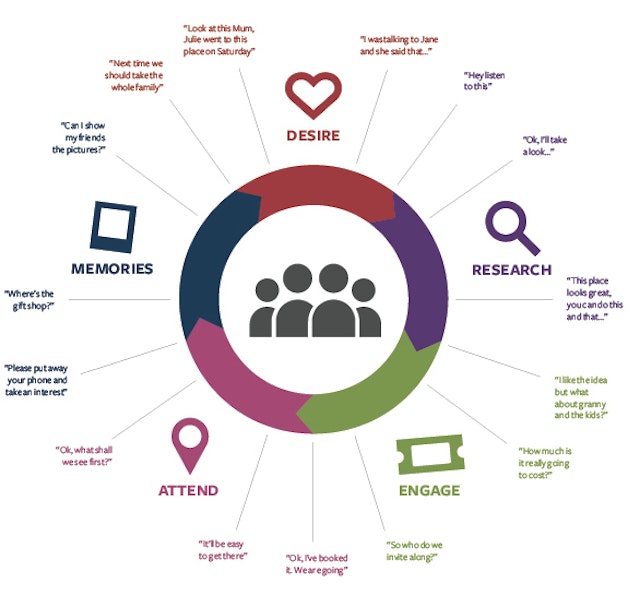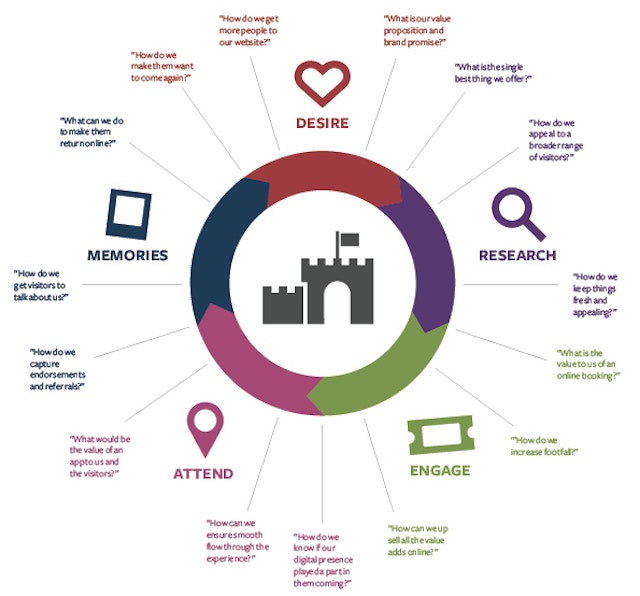Digital communications and engagement plays a crucial role in both recruiting visitors to an attraction and in ensuring that they have a satisfying and rewarding experience of it; one that they will want to talk about and share with their family, friends and peers.
The visitor’s broader experience of an attraction’s brand no longer starts at the entrance gate. It begins online. It is therefore essential that attention to detail is paid to any attraction’s digital presence when considering the overall experience that is offered to the public.
Recently Precedent reviewed the digital presence of over 200 attractions in the UK and Australia in order to identify elements of best practice for our new sector report on attraction brands' online experience. The report looks at the customer recruitment to retention process based upon the concept of the DREAM day out, facilitated, reinforced, shared, augmented and experienced in a digital environment. It is framed around the model below, the implication of which is that at each stage of the cycle the visitor has digital needs which the attraction must meet, and the attraction has a number of objectives that can be met with the careful application of best practice.
Customers' DREAM cycle
Marketers' DREAM cycle
Overall it seems clear that the majority of attraction brands, while recognising that their website and broader digital presence play an important role in their marketing efforts, do not have the level of online sophistication to be as effective online as they are offline.Part of any attraction’s plans for a new season, or busy times in their promotional calendar, is to reassess the venue on offer and consider how it can be improved, added to, or talked about differently. Constant refinement and maintenance is part and parcel of the senior management’s ongoing work. However the evidence is that the same planning and preparation that is applied to the physical environment is not applied to the digital.BDRC Continental's recent ‘Five Trends for 2013’ report notes that online sources are used most by the committed customer who is researching the venue they intend to visit – between the 'Research' and 'Engage stages' of our engagement cycle. Our investigations revealed that this is where attractions seem to apply the most effort, but of course this is the stage of the cycle that sits most comfortably with the traditional attraction marketers’ understanding of what sells. It is at this point that they need to answer the simple questions – Where is it? How do I get there? How much? What’s on offer? We were able to identify some great examples of attractions that answered all of the ‘what will it be like?’ questions, but struggled to find examples of refined digital landscapes that offered visitors a satisfying and integrated digital experience across the DREAM cycle.What this means is that attractions are missing opportunities to fully optimise their digital environments. Here are some key observations related to the stages of our engagement cycle model, as well as some examples of attractions which have got it right.
DesireThis is the point where the cycle potentially completes with a digital ‘word of mouth recommendation’ via a social network, or peer review site.
The Ashmolean Museum (www.ashmolean.org)The Ashmolean is a prolific user of social channels, all of which are very well integrated and consistent. Although in some instances followers, pins, circles, and so on, are modest in number, there is no doubt that the museum will eventually come onto the digital radar of any member of the art and archaeology community. The museum has fostered relations with like-minded institutions and is very good at updating its channels, keeping them current with exhibition information, and also interacting with visitors and facilitating them in recording their visits. The sentiment across all of its channels is remarkably positive, and likely to impress anyone thinking of paying the attraction a visit.
ResearchAt this point the website needs to match the brand promise by having a very clear idea of the experience it is selling.
Eureka Skydeck 88 (www.eurekaskydeck.com.au)In essence the Skydeck has one experience to offer – a view over a city. However, it makes the very most of this asset with a compelling brand promise, a series of well-crafted supporting messages, excellent photography, and a persuasive video that encapsulates every aspect of the experience on offer. Skydeck is selling an experience, and experience is a word that is never far from the copy it uses on its website, printed material and the narrative of its videos.
EngageThe user experience is critical to the visitor at this point, and it is the point at which the attraction can interest visitors in additional products.
Go Ape (www.goape.co.uk)The ticketing engine of the Go Ape website illustrates the principles that deliver a superior user experience, increase the chances of conversion and completion, and maximise the opportunity to up-sell. The bespoke nature of the interface on desktop and mobile ensures that users feel like they are buying an experience, not a bag of shopping.
AttendDigital engagement often ends for attractions here. Mobile sites and apps offer the opportunity not only to facilitate and enhance the visitor experience, but also to maintain engagement during and after attendance. Strangely, very few attractions offer the opportunity to download an app at the point of ticket purchase, the time at which it would be most attractive.
MemoriesDigital memories can be captured at or shortly after leaving the venue, but how to maximise this opportunity seems to be a rarely answered question.The BDRC Continental report identifies investment in ‘visitor-facing’ staff as a way of ensuring ‘the greatest visitor experience benefits’. We would maintain that part of this investment should be to educate staff in the possibilities that digital channels afford. All staff should be aware of the importance of digital engagement so that they can point out opportunities to do so to visitors.Attraction brands need to look closely at their digital engagement strategies. They should consider that, in comparison to other marketing activities, the benefit of digital is that it is infinitely measurable, has enormous potential reach, and can be adaptive, responsive and reactive. Most importantly, with proper maintenance and investment, it is sustainable. In short, whereas there is still a place for the leaflet and the advertorial, digital doesn’t get thrown in the bin tomorrow, or forgotten when the next advert appears.
For a free copy of the report please go to www.precedent.co.uk 

